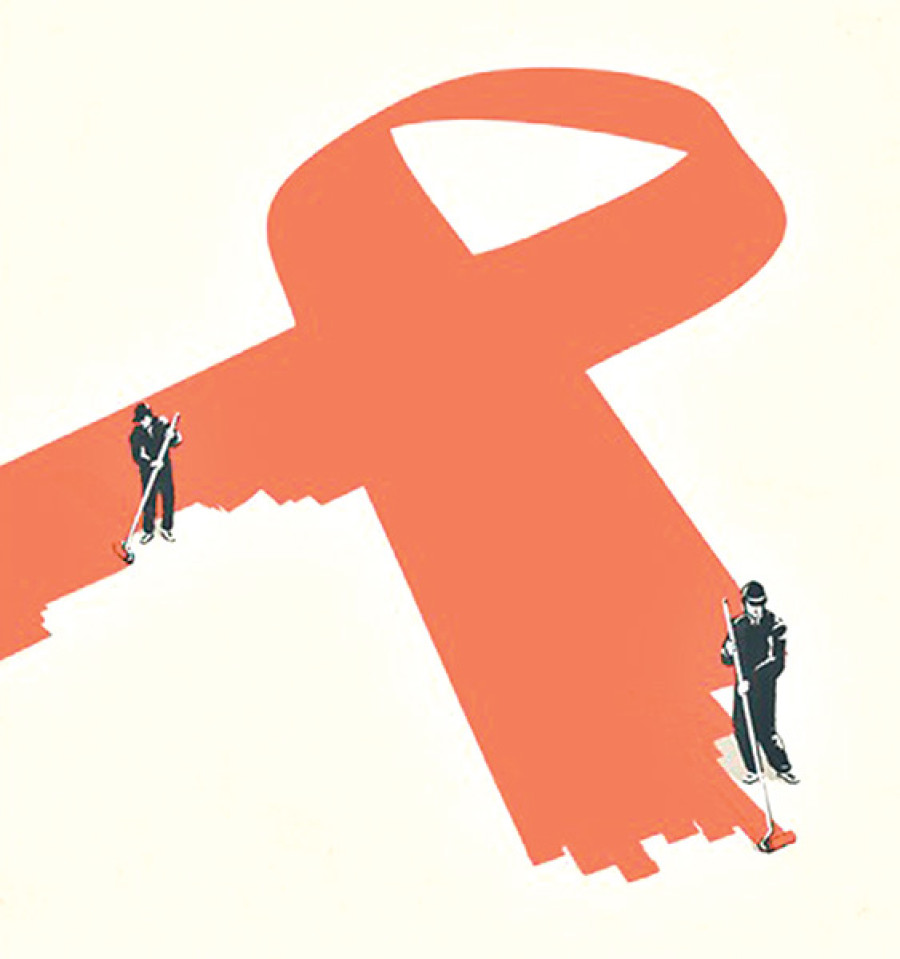Opinion
Nepal HIVision 2020
The global HIV (human immunodeficiency virus) epidemic claimed fewer lives in 2015 than at any point in almost two decades.
Binod Rayamajhee & Bishnu Joshi
The global HIV (human immunodeficiency virus) epidemic claimed fewer lives in 2015 than at any point in almost two decades. Prevention programmes reduced the number of new HIV infections globally per year to 2.1 million in 2015, a 35 percent decline since 2000. A massive expansion in antiretroviral treatment reduced the number of people dying of HIV related causes to approximately 1.1 million in 2015, down 45 percent from 2005. By mid-2016, 18.2 million people living with HIV were receiving antiretroviral therapy (ART) globally. Sub-Saharan Africa is the most affected region with 25.6 million people living with HIV in 2015. The region accounts for two-thirds of the global total of new HIV infections.
Substantial progress
Nepal has been able to make some substantial progress in HIV/AIDS response, although there is a lot that needs to be done. Nepal has made a significant achievement in reduction of new HIV cases from 7,512 per year in 2,000 to 1,331 in 2015. The highest rate of infection is found among certain vulnerable groups like drug users and sex workers. Furthermore, the prevalence of hepatitis B, hepatitis C and tuberculosis co-infection is higher in the HIV infected population. The prevalence among the active population has declined from 0.34 percent in 2005 to 0.2 percent in 2015. A new fast-track HIV plan aims to end the AIDS epidemic in Nepal by 2030.
Health Minister Gagan Kumar Thapa launched the National HIV Strategic Plan, NHSP 2016-2021: Nepal HIVision 2020, in Kathmandu on World AIDS Day, December 1, last year. The five-year plan will accelerate action by focusing strategic investments in HIV programmes for and with key populations in priority geographical areas. The NHSP ensures that everyone can access services for HIV prevention, treatment, care and support.
The first case of HIV infection was recorded 35 years ago. Since then, increasingly effective preventive efforts have reduced the number of new infections. The expansion of ART has resulted in a substantial reduction of AIDS-related deaths. ART was started in Nepal in February 2004 from Shukraraj Tropical and Infectious Diseases Hospital, Teku. Currently, ATR services are being provided from 62 sites in 55 districts, and tests to measure the number of CD4 cells are being provided by 27 centres. Likewise, there are 263 HIV testing and counselling centres throughout the country.
Regular coordination between local communities and public stakeholders is essential for the continuation of the ‘Test, Treat and Retain’ programme. According to recent research findings, the rate of HIV infection among drug users is 6.4 percent in Kathmandu, 2.8 percent in Pokhara and 8.3 percent in the Tarai. The infection rate is 2 percent among female sex workers and 2.4 percent among homosexual men in Kathmandu. Likewise, the rate of HIV infection is 0.3 percent in the western region and 0.6 percent in the mid- and far-western regions. The United Nations has set a target to diagnose 90 percent of the people with HIV by 2020. Currently, it is estimated that only 60 percent of the people with HIV are aware of their infection. The World Health Organisation has been working on HIV self-testing since April 2013, and provides global guidance encouraging countries to implement self-testing.
Treatment methods
The Joint United Nations Programme on HIV/AIDS (UNAIDS) has focused on fast track treatment targets known as the 90-90-90 targets: 90 percent of all those living with HIV will know their HIV status, 90 percent of all those living with HIV will receive antiretroviral therapy, and 90 percent of all those receiving antiretroviral therapy will have viral suppression. This means HIV can no longer be detected in their blood, and they can consider themselves ‘non-infectious’. One of the most successful prevention methods on the market today is PrEP which is vital to defeat HIV. It stands for Pre-Exposure Prophylaxis, and is a pill taken once a day which virtually eliminates the chances of getting HIV.
A safe and effective vaccine offers the best hope of controlling the worldwide AIDS epidemic. Viral vaccines are typically preventive, which means they are given to uninfected individuals to prevent infection or disease. However, all candidate HIV vaccines tested as of 2009 proved to be ineffective in preventing infection. Without control by drugs or vaccines, the only way to avoid the epidemic spread of HIV is to maintain a lifestyle that minimises high risks factors. There is a risk of infecting others by sexual intercourse, by oral-genital contact, or by sharing of needles. In Nepal’s case, unsafe sexual intercourse accounts for 85 percent of HIV transmission. Consistent and proper use of condoms can reduce transmission of the virus though protection is not certain.
Integration of HIV and family planning, early infant diagnosis (EID), TB/HIV services and moving towards monitoring HIV drug resistance are some of the best global practices in recent times. Individuals can reduce the risk of HIV infection by limiting exposure to risk factors. Major approaches to HIV prevention are using a condom during sexual intercourse, HIV testing and counselling, tuberculosis treatment, regular use of ART for prevention, and avoiding injection by drug users.
Another key investment will be in Community Test and Treat Competence (CTTC) as an innovative way of working in and with communities to identify community strengths and stimulate positive attitudes and actions to increase HIV testing. About $18 million has been invested in Nepal’s HIV response, with only 15 percent of the funding coming from domestic sources. In order to fast-track HIV response, it is estimated that $30-40 million will have to be spent annually over the next five years. Sustainable and priority investments with increased funding from domestic sources are vital.
Joshi is a PhD candidate at the Department of Medical Biology, Arctic University of Norway; Rayamajhee holds an MSc in medical microbiology from Tribhuvan University




 13.12°C Kathmandu
13.12°C Kathmandu










